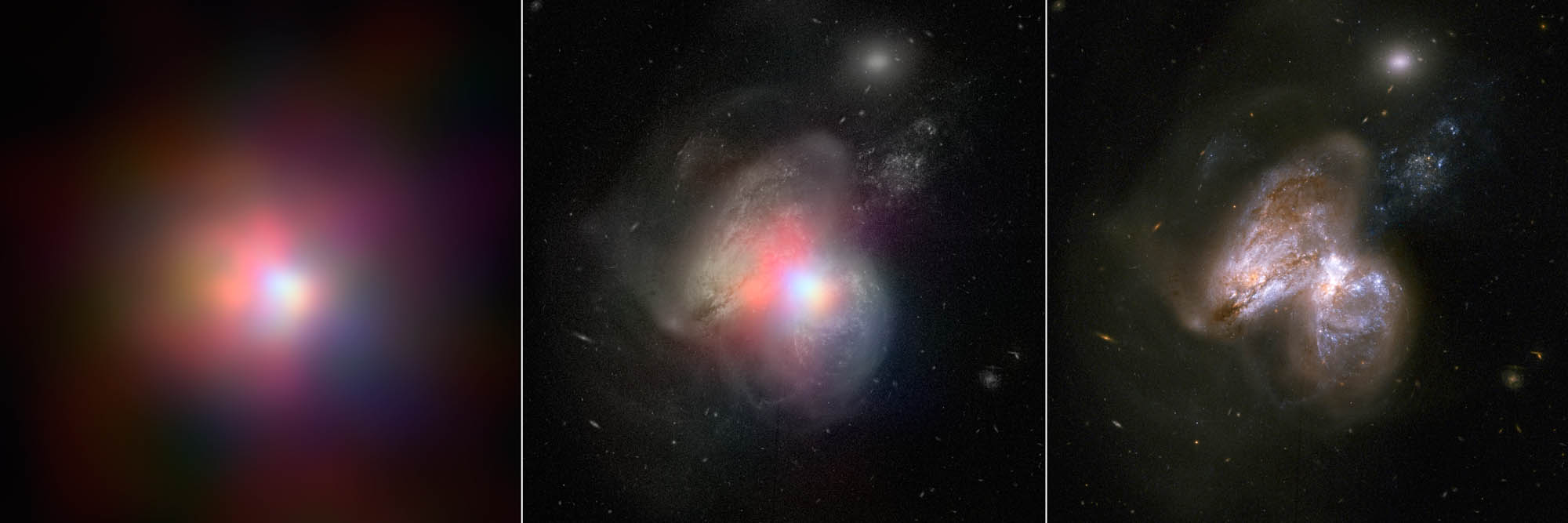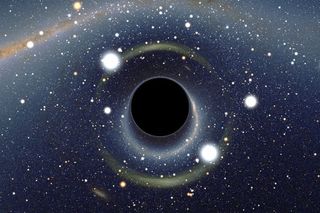Monster Black Hole Caught Feeding in Galaxy Crash

A NASA space telescope has spotted a colossal black hole chowing down on gas from a distant collision between two doomed galaxies. Views of the cosmic smashup, which the swirl of gas and dust previously hid, will likely shed light on the evolution of galaxies, scientists say.
The new view of the colliding galaxies — known collectively as Arp 299 — was captured by NASA's Nuclear Spectroscopic Telescope Array (NuSTAR), an X-ray space telescope built to hunt black holes. The galaxies in Arp 299 are about 130 million light-years from Earth and made a close pass by each other about 700 million years ago, sparking a fierce burst of star formation. Now, some stars from the galaxies are turning to dust via huge supernova explosions.
But star formation isn't the only result of such supermassive collisions. As two galaxies merge, the chaos should send gas flowing to the central black holes. This collision-induced feeding frenzy by black holes helps explain how the objects grow to be millions to billions of times the mass of the sun. [NuSTAR: NASA's Black Hole Telescope in Pictures]
"We want to understand the mechanisms that trigger the black holes to turn on and start consuming the gas," the study's lead researcher, Andrew Ptak, of NASA's Goddard Space Flight Center in Greenbelt, Maryland, said in a statement.
Although previous space telescopes, including NASA's Chandra X-ray Observatory and the European Space Agency's XMM-Newton, have observed Arp 299, they were only able to probe the low-energy X-rays emitted by the collision and unable to see if one or both of the black holes were actively chomping down gas.
"Odds are low that both black holes are on at the same time in a merging pair of galaxies," said co-author Ann Hornschemeier, also of NASA’s Goddard Space Flight Center, referring to the black holes’ ability to munch down gas and shine brightly. "When the cores of the galaxies get closer, however, tidal forces slosh the gas and stars around vigorously, and, at that point, both black holes may turn on."
NASA's NuSTAR space telescope, launched in 2012, is the first observatory capable of spotting high-energy X-rays and therefore making sense of the tangled galaxies in Arp 299. The new image shows that the black hole in the galaxy on the right is indeed the hungry one. Meanwhile, the black hole on the left is likely dormant or hidden by thicker layers of gas and dust.
Get the Space.com Newsletter
Breaking space news, the latest updates on rocket launches, skywatching events and more!
"Before now, we couldn't pinpoint the real monster in the merger," said Ptak.

As an added bonus, the galaxies' two black holes themselves will eventually merge, shaking the fabric of space-time and producing gravitational waves that propagate outward like ripples on a pond.
The study, which has been accepted for publication in the Astrophysical Journal, was presented Thursday (Jan. 8) in Seattle at the 225th American Astronomical Society meeting.
Follow Shannon Hall on Twitter @ShannonWHall. Follow us @Spacedotcom, Facebook and Google+. Original article on Space.com.
Join our Space Forums to keep talking space on the latest missions, night sky and more! And if you have a news tip, correction or comment, let us know at: community@space.com.

Shannon Hall is an award-winning freelance science journalist, who specializes in writing about astronomy, geology and the environment. Her work has appeared in The New York Times, Scientific American, National Geographic, Nature, Quanta and elsewhere. A constant nomad, she has lived in a Buddhist temple in Thailand, slept under the stars in the Sahara and reported several stories aboard an icebreaker near the North Pole.










